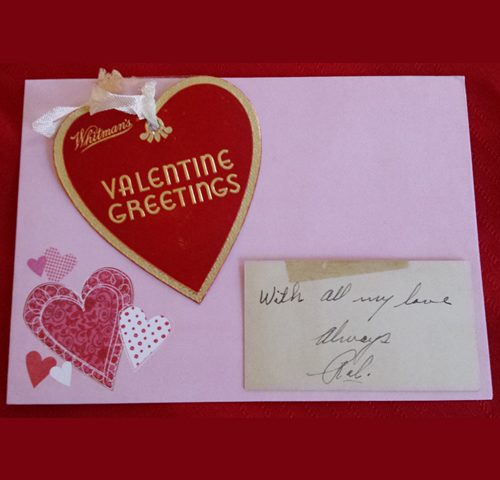Happy Valentine’s Day WWII Style

Unforgettable Valentine’s Day Fun
February 4, 2017
A Favorite New Read
February 10, 2017Valentine’s Day is less than a week away but have you bought your sweetheart a card or a gift yet? You might be thinking there’s no need to panic as there’s still plenty of time to buy a card, candy or flowers. Ok, but what if you need to mail that card or gift? Of course, you can use Amazon Prime or an overnight shipping service, so there’s still no need to worry. Plus, you might access one of the electronic greeting card sites that even include a special love song. Yes, you still have lots of time and plenty of options to help you celebrate your special Valentine.
But if you were a service member during WWII or a family member at home, it would already be too late to get anything to your sweetheart on time. How much planning and time would it actually take to send a package or a card to someone stationed in Europe or the Pacific in 1943? In 2017, we can’t imagine a three-five week time frame for a first class letter to reach its destination. But that was fairly typical for the families who were sending letters, cards, and packages to their loved ones in foreign countries.
Valentine’s Day was a special holiday for sweethearts and spouses of my parent’s generation. My dad, Rol Jett and my mother Virginia were no exception. Heart-shaped boxes of chocolates, flowery cards, and Air Mail Specials were typical gifts my mother received. During her early twenties, she had many beaus including Rol and she noted in her diary what she received each February 14th. This was always an exciting day for her as she enjoyed this attention from the men in her life. As her feelings for Rol deepened, she was upset the year that he had not given her a Valentine. But that would soon change.
Valentine’s Day 1942 was unlike any others they had experienced as it was overshadowed by the increasing war activities. This was supposed to be an exciting year for them as they had announced their engagement in late December and were planning a March wedding. When Rol received his notice to take his Army physical exam on February 12, their future quickly became very uncertain. While they celebrated Valentine’s Day dancing with their friends at Southland, the war news dampened their spirits. Two short weeks later their world was turned upside down when Rol was inducted into the Army at Ft Oglethorpe, Georgia, and their March wedding was cancelled. Eventually they did get married in a simple ceremony in late November, but these sweethearts would soon be living miles apart. Also, it would be several years before they would celebrate another Valentine’s Day together.
So how did they acknowledge their love and affection for each other on Valentine’s Day during the war years? It was definitely not in the traditional ways that they had enjoyed during their courtship. They weren’t even together to celebrate their first Valentine’s Day as a married couple in 1943 as Rol was on maneuvers in Columbus, Mississippi. There was no dancing and no box of chocolates, just a simple card. However, Virginia did get a surprise from him that was better than chocolates or flowers. He called her long distance. Sadly this would be their last Valentine’s Day to talk and share tender sentiments over the phone. Three months later Rol was sent to San Francisco and by the middle of June he was in Australia.
Now 9,000 miles separated them so how did they bridge that distance gap and keep their love alive every day? They wrote letters…many of them and often and they learned to deal with the insecurity of delayed and sometimes lost correspondence. At first, neither of them knew how long it would take for the letters and the food packages to arrive. Yet, they calculated the timing by noting the date the letter was written, the postmark and its arrival. Rol would immediately write his wife when he received her letters and she did the same so they could easily track their mail service. Patience, faith and hope were essential to surviving those challenging years but their letters were the lifeline that reinforced these feelings and sustained them.
While chocolate, cards, or gifts had been their normal Valentine’s Day exchanges, these were not as important as they had been. The most important gift was receiving a letter and knowing the person was safe and healthy. Rol had always been generous so he wanted to give his new wife presents. But what do you get someone when you are in the jungles of New Guinea and far from civilization? There were no shopping malls or stores where Rol could buy something and he often apologized about that. But he promised that he would make it up to her. One consolation was that he sent most of his paycheck home and encouraged her to buy something special.
Regardless of the holiday or special event, they both had to plan carefully to ensure that the mail or package got there on time. Can you imagine shopping for a Valentine card in early January to ensure that it reaches your husband by February 14? Can you imagine packing a box with food that could survive the distance and rough conditions of a four-six week journey with war supplies and equipment? Can you imagine the logistics in sending and receiving mail in Rol’s remote camps? Eventually they both learned the ebb and flow of the war mail service and were thrilled when a package or letter finally arrived with the latest news. When that happened, every day was Valentine’s Day…an opportunity to shower someone with love, appreciation, support and hope for their brighter future.
So as you make plans for your Valentine’s Day celebration, know that on this February 14, 2017, you have many timely ways to express your love. But first, acknowledge your parents for their service and sacrifice, especially those who were part of the WWII era. Thanks to them, we now enjoy many freedoms and have technological resources that provide speedy solutions to our last minute Valentine’s Day challenges. Happy Valentine’s Day, veterans, service members and sweethearts everywhere!

